What Clear Coat Do You Use on a Painted Surface
When I first started painting furniture, the thing that confused me the most was when to use a topcoat or sealer and which one to use.
I very quickly learned that not all sealers are created equal. Some work on stained furniture but cause paint to yellow. Some leave a milky film when applied over dark paint colors. Some need to be reapplied regularly. And some work like a dream.
Since then, I've painted dozens of pieces of furniture and I've learned a ton about how to protect painted furniture so it continues to look beautiful for years to come.
And I've learned that the topcoat or sealer you choose to use on your painted furniture can affect the final outcome as much as your choice of paint, if not more.
I've shared tons of painted furniture makeovers here over the years as well as a step-by-step guide to painting furniture that walks you through all of the decisions related to painting your specific piece of furniture. And I figured it is definitely time to share all I've learned about choosing the perfect sealer to finish off your painted furniture.
In this post, I am answering the questions I am asked most frequently about sealing painted furniture and also sharing reviews of the most popular sealers available to make it easier to choose the perfect sealer for your next project.
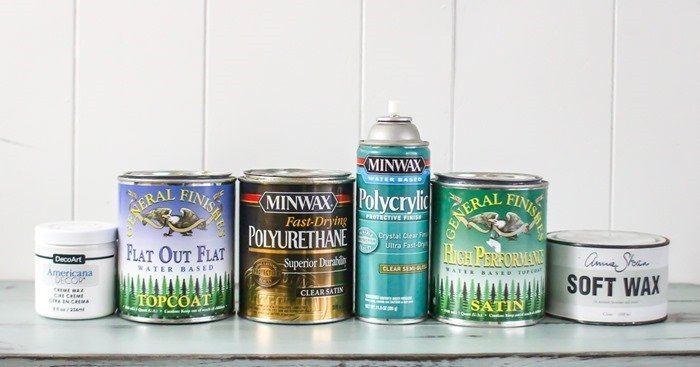
This post contains affiliate links which means if you make a purchase after clicking a link I will earn a small commission but it won't cost you a penny more. Click here to see my full disclosure policy.
What does a sealer even do?
A sealer, which may also be called a topcoat, simply protects your beautiful paint finish from stains, scratches, chips, and scuffs.
Topcoats dry to a much harder finish than most paints and therefore are much harder to damage. Sealers also help protect your painted furniture from water and create a surface that can be easily cleaned without damaging the paint underneath.
When I first started painting furniture, I didn't really understand why you would need to put sealer over the paint. I had painted walls plenty of time and they certainly didn't need any sealer afterwards.
Of course, painting furniture and painting walls is very different. Drywall is extremely porous and absorbs paint easily; if you scratch your walls with a fingernail, you aren't likely to be able to scratch the paint off because it adheres so firmly.
Painting furniture is an entirely different matter. Paint doesn't permeate the hard woods furniture is made of as easily. It also doesn't bond as firmly to the old finishes we are typically trying to paint over. Which means painted furniture is often vulnerable to being easily scratched and chipped.
On top of that some paints stain and scuff very easily and can be difficult to clean. Sealing your painted furniture protects it from all of these potential issues.
When do you need to seal painted furniture?
It can be confusing knowing when you have to seal painted furniture and when you do not. There are a few basic rules to keep in mind.
- Any time you paint furniture with chalk paint, you need to protect the finish with a sealer or topcoat. Every single time.
- Most times you paint furniture with latex paint, you need to protect the finish with a sealer or topcoat. If you are painting a piece of furniture that will not be heavily used, you may be able to skip the sealer. If you do, be sure to be extra gentle with your furniture for the first month of use. Even though the paint may feel dry to the touch, it can take up to 30 days for it to fully harden.
- There are some other paints that do not require a sealer including General Finishes Milk Paint and Fusion Mineral Paint . These paints have some self-sealing properties and do not require a topcoat, but I have learned the hard way that even these paints can become worn and scratched when used on high traffic surfaces like tabletops, shelves, and kitchen cabinets. In those cases, using a topcoat will help ensure your paint job lasts longer.
How to seal painted furniture
There are several different ways you can apply furniture sealer: with a paint sprayer, with a paintbrush, with a wax brush, with a rag, or with an applicator sponge. The specific method you use will depend on which sealer you are using.
Be sure to carefully read the instructions on your specific sealer for recommended application methods. Also, pay close attention to the temperature recommendations on your sealer; working in conditions that are too cool or too warm can make it impossible to get an even finish.
Before applying your sealer, make sure to stir it thoroughly; do not shake topcoats to mix them as this can cause air bubbles to form,
In general, you want to apply furniture sealer using multiple thin, even coats. At least two thin coats of sealer is recommended but I usually apply 3-4 coats of sealer on high-traffic pieces.
If you are using a brush to apply furniture sealer, brush it on in long, even strokes. Try to work from one side of your piece to the other so that as you are overlapping your brushstrokes and your paintbrush never touches areas that have already begun to dry. Also, resist the urge to touch up your finish before it has completely dried.
A paint sprayer is a great way to get a flawless finish on your painted furniture, but I have also had great luck getting a very smooth finish using this $3 applicator sponge .
( This is the paint sprayer I use ; it's easy to use and doesn't require an air compressor.)
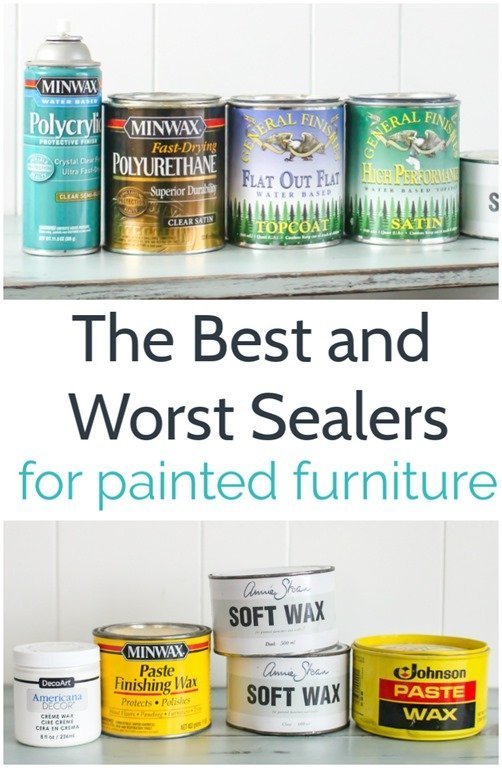
Which furniture sealers are the best?
There are a lot of furniture sealers out there these days. Each new line of furniture paint that debuts also has its own sealer or topcoat.
I certainly have not tried every topcoat from every paint line, but I have tried the most widely available sealers as well as those that have the strongest reputation.
Each sealer has strengths and weaknesses and I have tried to be as objective as possible in my assessment of them.

Minwax Polycrylic
- Price: $13-$20 per quart
- Availability: Available on Amazon or at your local home improvement store.
- Formula: Water-based, non-yellowing
- Finishes: Comes in Matte, Satin, Semi-Gloss, and Gloss finishes. This polycrylic comes in a spray version as well as a brush-on version .
- Application: Can be applied with a brush or sprayed. This sealer is not always the easiest to work with. When applied with a brush, it is more difficult to avoid brushstrokes and get a nice smooth finish. I have also found that it tends to leave a milky white finish over dark paint colors and can appear yellow if applied too thickly over white paint. But if you use a quality paintbrush and apply thin, even coats, it can work well.
- Verdict: In my opinion this sealer isn't nearly as easy to work with as the General Finishes sealers. However, it is cheaper and can easily be found at your local home improvement store so it wins as far as convenience. And though it can be more difficult to work with, it does give a very durable finish.
- Pieces I have used this sealer on:
- Pair of Nightstands from an Old Vanity
- Bathroom Vanity made for a Vintage Dresser
- Bold Kids Table and Chairs
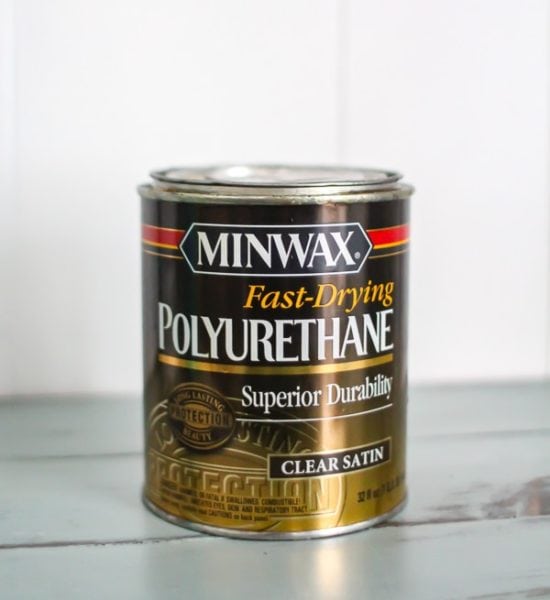
Minwax Polyurethane
- Price: $10-$20 per quart
- Availability: Available on Amazon or at your local home improvement store.
- Formula: Oil-based.
- Finishes: Comes in Satin, Semi-Gloss, and Gloss finishes. This polyurethane comes in a spray version as well though I have never tried it.
- Application: Can be applied with a brush, a foam brush, or wiped on with a rag. Polyurethane is generally easy to apply but it isn't quite as forgiving as General Finishes High Performance Top Coat. If conditions aren't completely optimal, you may be left with a streaky or bubbly finish.
- Verdict: I often use Minwax polyurethane to seal stained wood furniture because it is inexpensive and is conveniently available locally. It is not a good topcoat for painted furniture because it yellows and will affect the appearance of the paint color.
- Pieces I have used this sealer on:
- Refinished Dining Room Table
- Trash to Table Dining Table
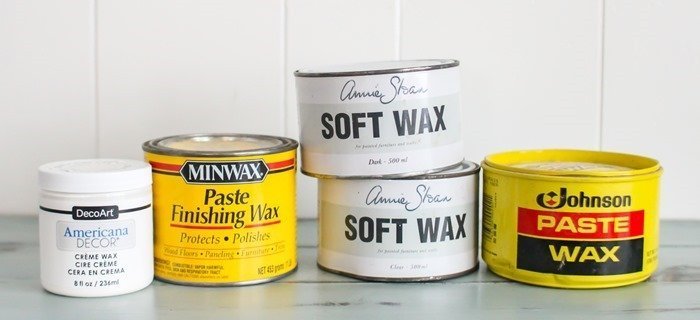
Furniture Wax
- Price: $8-$25 per pint (Note, this is the price per pint, while the other sealers have the price per quart listed. Even thought the quantity is different, the square footage covered by this amount of wax is comparable to the coverage from a quart of liquid sealer so this is a fair price comparison.)
- Availability: There are many different brands of furniture wax. Personally I have tried Annie Sloan wax , Johnson paste wax , and Americana Decor Creme Wax. Some are definitely better than others, but I am listing them all together here because they all work essentially the same way. Many waxes are available on Amazon and Etsy , but Annie Sloan wax is only available from Annie Sloan Chalk Paint retailers.
- Formula: Typically available in clear, white, or dark wax colors. Dark wax is a wonderful way to add a bit of antiquing to the details of a piece.
- Finishes: Most wax dries to a more matte finish and can be buffed until the desired sheen is reached.
- Application: Wax can be applied with a rag or a wax brush and then buffed with a clean cloth.
- Verdict: I personally find it difficult to apply wax well. It is very easy to apply way too much wax and a bit of a pain to remove the excess. Wax is also generally not as water-resistant or as tough as other sealers. It needs to be reapplied regularly in order to continue to effectively protect the paint underneath. I know that some furniture painters love wax, but I am not a fan. It is more difficult to apply than other sealers, yet it isn't as long-lasting and durable. Of the furniture waxes I have used, Annie Sloan was by far my favorite.
- Pieces I have used this sealer on:
- Pop of Green Side Table
- Napoleonic Blue Side Table
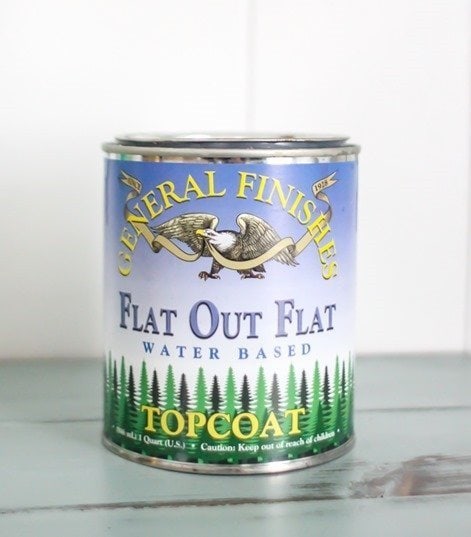
General Finishes Flat out Flat
- Price: $25-$30 per quart (You may notice a pint costs nearly as much as a quart in many stores. It is definitely worth going for the quart.)
- Availability: Available on Amazon or look for a local store here .
- Formula: Water-based, non-yellowing
- Finishes: This is a completely matte finish which is ideal for pieces that you want to have a more vintage, aged look. Flat out flat is advertised as a more durable alternative to furniture wax.
- Application: Goes on easily with a smooth paintbrush, a foam brush or sprayed with a paint sprayer.
- Verdict: This is my favorite sealer for distressed furniture or any furniture you want to have a vintage feel. This is also my favorite sealer to use over chalk paint for a completely matte finish. It is extremely easy to apply and gives a beautiful flat finish that protects well.
- Pieces I have used this sealer on:
- The painted frame on my Reupholstered Vintage Sofa
- Chippy Farmhouse Blue Dresser
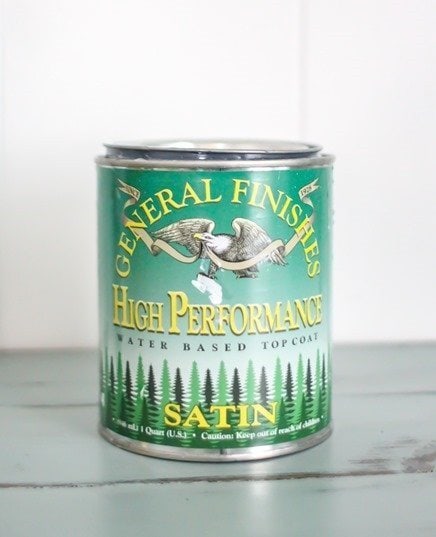
General Finishes High Performance Top Coat
- Price: $25-$30 per quart (Again, buying a quart is much more cost effective than buying a pint.)
- Availability: Available on Amazon or look for a local store here.
- Formula: Water-based, non-yellowing
- Finishes: Comes in Flat, Satin, Semi-Gloss, and Gloss (It's important to know that the matte finish is not truly flat and still has a slight sheen.)
- Application: Goes on easily with a smooth paintbrush, a foam brush or sprayed with a paint sprayer. Can also be used over stained wood or other oil-based products. Just make sure the stain is completely dried first – you need to wait at least 24 hours.
- Verdict: This is my number one pick for a great all-around sealer. It is easy to apply, holds up well, and works well over all kinds of paint and stain. I have never had a problem when using this sealer.
- Pieces I have used this sealer on:
- Neutral dresser
- Black kitchen chairs (painted with paint sprayer)
- Gray and White Ombre Dresser
- Color-dipped IKEA stepstool
Dixie Belle Gator Hide
- Price: $25-$32 per quart
- Availability: Available on Amazon and Etsy or look for a local retailer here .
- Formula: Water-based, non-yellowing
- Finish: Gator Hide has a very low sheen, close to a matte finish.
- Application: Can be applied with a brush but you will get the smoothest finish using Dixie Belle's popular blue sponge applicator .Gator Hide is formulated to provide a very durable finish for tabletops, counters, outdoor furniture, and other pieces that get a lot of wear and tear.
- Verdict: I haven't personally had a chance to try Gator Hide yet, but I had to include it because it comes so highly recommended by other bloggers and furniture painters. If you have used it, I would love to know what you think.
Those are my picks for the best and worst furniture sealers. What would you add to the list? Do you have a favorite that I need to add to my list of products to try?
Here are a few more furniture painting posts I think you'll find helpful:
- How to Paint Furniture for the Perfect Finish Every Time
- What is the Best Paint for Furniture?
- The Best Paintbrushes for a Perfectly Smooth Paint Finish
- Everything You Need to Know about Primer

What Clear Coat Do You Use on a Painted Surface
Source: https://www.lovelyetc.com/the-best-and-worst-sealers-for-painted-furniture/
0 Response to "What Clear Coat Do You Use on a Painted Surface"
Post a Comment